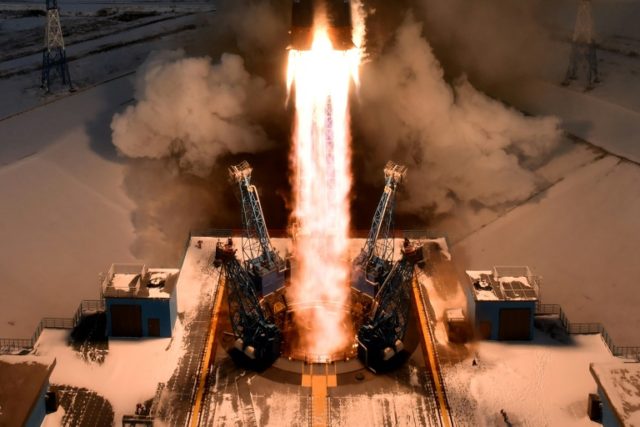WASHINGTON, DC — U.S. military satellites used to warn of a missile strike or to deploy nuclear weapons are vulnerable to attacks by the Chinese and Russian armed forces, which have eclipsed their American counterparts in developing some significant space warfighting capabilities, experts cautioned lawmakers.
Specifically, the United States is “over a decade” behind in developing a system to counteract the advancements made by China and Russia in the anti-satellite (ASAT) weapons domain, Douglas Loverro, the former U.S. deputy assistant secretary of defense for space policy, warned a House panel.
Echoing the U.S. intelligence community in written testimony prepared for a House Armed Services Committee hearing on Wednesday, the former Pentagon official noted:
While China and Russia are driving through generations of ASAT systems every three to five years, it is taking us over a decade to even begin to field a system responsive to their first-generation threat.
Stated more clearly, when it comes to strategic missile warning and nuclear command and control, the evolved US response to the ASAT threat we see being deployed today will be ready near the end of the next decade; meanwhile, the threat will have [leaped] forward two more generations, and likely made our response moot.
The U.S. armed forces consider “maintaining space superiority” one of its primary goals, top American military officials have recently stressed, noting that “space is now a warfighting domain.”
William Carter from the Center for Strategic and International Studies (CSIS) warned lawmakers in January that China is “rapidly closing the gap” with America in developing “cyber capabilities, anti-satellite weapons, electronic warfare tools, hypersonic weapons, artificial intelligence, and quantum technologies.”
Carter pointed out that China has deemed satellites to be the U.S. military’s “Achilles heel.”
While testifying before the House panel on Wednesday, Todd Harrison, another CSIS expert, reiterated that the American armed forces’ “dependence on space across the full spectrum of conflict” renders the U.S. vulnerable to its top ASAT domain rivals, Russia and China.
“Adversaries can use forms of attack against our space systems that are difficult to detect, attribute, and deter. … Much remains to be done to improve the readiness of our national security space forces for the wide range of threats,” Harrison noted in his written testimony.
Two of the three witnesses flat out told House lawmakers on Wednesday that the American military is not ready to take on adversaries like Russia and China in space.
Retired Gen. Robert Kehler, who served as the head of U.S. Strategic Command (STRATCOM)—charged with overseeing America’s space warfighting capabilities—testified:
The United States is perilously close to losing the significant advantages that come from being the world’s leading spacefaring nation, and time is not on our side.
…
From simple (and widely available and affordable) GPS jammers in the hands of extremists to highly sophisticated anti-satellite (ASAT) weapons in the hands of near‐peer competitors like Russia and China, today’s military commanders are facing serious threats in a domain that is increasingly congested, contested, and competitive. Our space advantages have eroded and will continue to do so if action is deferred or delayed.
Consistent with the general’s warnings, Loverro, the former Pentagon official, explicitly said America’s space warfighting forces are not yet ready for conflict.
“We are not ready, or more properly, we are not on a firm path to be ready,” he told lawmakers.
Nevertheless, Loverro stressed that while the U.S. military and intelligence community stands ready to maintain America’s dominance in space, they lack the tools to do so, adding:
No adversary should mistake that statement an invitation to attack. The fact of the matter is that US space capabilities are robust and, faced with any attack that could be mounted today, I am fully confident that they will continue to provide the US with sufficient warfighting edge to assure an adversary’s defeat.
But as we move into the future, as our adversaries begin to close the gap in other warfighting domains, and as they continue to field and expand their counterspace capabilities, that calculus could change.
U.S. President Donald Trump’s National Security Strategy deemed adversaries’ “counterspace” capabilities as a threat to the American homeland.
Meanwhile, the U.S. intelligence community predicted in its most recent Worldwide Threat Assessment that the latest generation of Russian and Chinese destructive ASAT weapons will be operational “in the next few years,” highlighting “counterspace” as one of the top perils facing the international community.
Despite the advancements made by the Chinese and Russian militaries in the space warfighting domain, they continue to trail behind the United States as the most powerful armed forces in the world, revealed the most recent Global Firepower (GFP) index, which ranks 133 countries annually.
Nevertheless, the experts urged American lawmakers on Wednesday to increase U.S. investment in developing the ability to defeat adversaries in space.

COMMENTS
Please let us know if you're having issues with commenting.